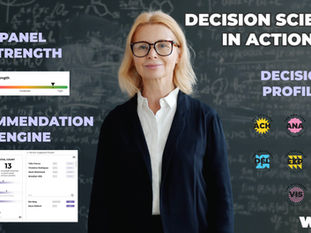
Blog Post

What Kahneman’s Thinking Fast and Slow Can Teach Us About Smarter Decision-Making at Work
Daniel Kahneman’s Thinking, Fast and Slow is one of the most influential books on decision-making ever written. It outlines two modes of thought—System 1, our fast, intuitive brain, and System 2, our slow, deliberate thinking process. At Wizer, we’ve built our decision-making platform around principles that align closely with this framework, helping organizations move from reactive decisions to smarter, more structured ones.
So how exactly does Wizer help bring Kahneman’s insights to life in teams and companies?

System 1 vs. System 2: Fast vs. Deliberate Thinking
Kahneman’s central idea is that we all have two decision-making systems:
System 1 is fast, emotional, instinctive. Great for snap decisions—but prone to bias.
System 2 is slower, analytical, logical. It’s better for complex problems, but requires effort and structure.
Wizer helps organizations bridge the gap between these systems.
Rather than letting quick judgments dominate important calls (System 1), Wizer creates the scaffolding to slow down when it matters—prompting reflection, structure, and inclusion (System 2). By curating panels and surfacing key dynamics, we reduce overreliance on instinct or status and build a stronger, more consistent decision culture.
Reducing Bias Through Structure
Kahneman’s research highlights dozens of cognitive biases—from groupthink and confirmation bias to overconfidence and availability bias. These biases distort our view of reality and lead to flawed decisions.
Wizer’s platform is built to identify and counteract these patterns.
Decision Profiles help leaders understand how individuals tend to think—so you know when you’re getting a single perspective over and over.
The Panel Strength Indicator ensures diversity is present—not just demographically, but in terms of thought, role, and experience.
The Recommendation Engine identifies who may be missing before decisions are made, prompting reflection before action.
By giving structure to how decisions are made, Wizer reduces the risk of bias clouding judgment.
The Power of Collective Intelligence
Kahneman’s work—and follow-up research by others—shows that groups can outperform individuals, but only when the group is well-constructed. Simply adding more people isn’t enough. It’s about independence, diversity, and the right kind of challenge.
Wizer applies these principles by:
Curating “wise crowds” of the right people for a given question.
Encouraging independence of thought before responses are aggregated.
Preventing dominance by status or volume—making sure all voices are heard.
This structured approach reflects the very best of System 2 thinking—without the time or effort that usually holds teams back.
Making Better Business Decisions with Behavioral Science
Business leaders don’t have time to read hundreds of behavioral science studies. Wizer brings that science into practice.
Whether you’re building a strategy team, making a major investment, or trying to improve how your people collaborate—Wizer helps turn decision-making into a repeatable, intelligent process.
It’s not about eliminating intuition. It’s about knowing when to slow down, who to include, and how to surface the best insights—before acting.
Key Takeaways
Wizer creates structure around important decisions, helping teams avoid snap judgments and bias.
Decision Profiles and group strength tools surface key gaps—from blind spots in leadership to missing diversity in thought.
Recommendation Engine ensures the right people are included—not just the usual suspects.
Kahneman’s insights are built into the platform—not as theory, but as action.
Want to see how Wizer applies behavioral science to real-world team decisions?
Explore our platform or take your own Decision Profile to see how your thinking style shapes your approach to strategy, risk, and collaboration.





